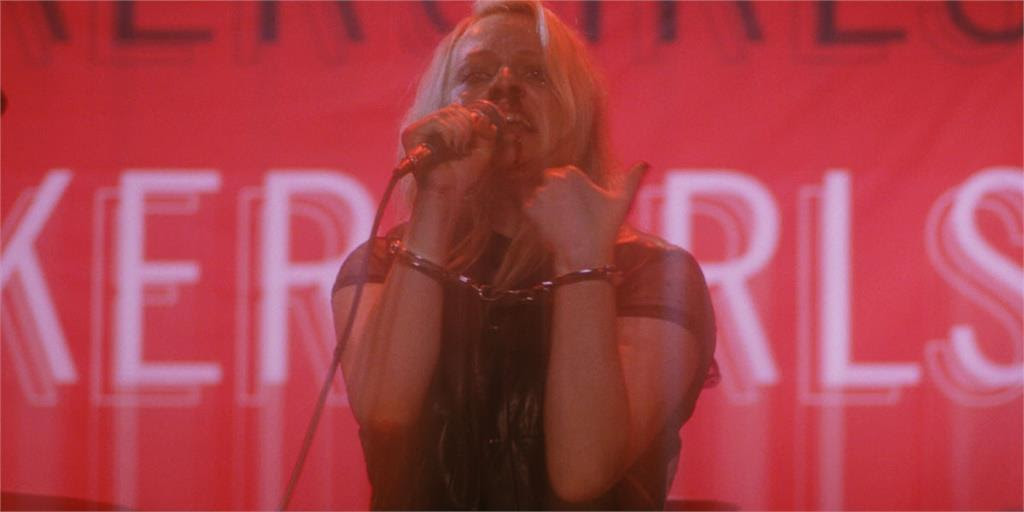There are few places I feel closer to the visual contours of a film than the Toronto International Film Festival. Here, mammoth multiplexes are taken hostage by the kinds of films one is more accustomed to seeing on modestly sized screens at your local art-house. Sometimes this can feel wildly inappropriate—at the 14-screen Scotiabank Theatre, I’ve seen many international small-scale character studies on screens regularly used for IMAX spectacles, which can sometimes cause an alienating incongruity. But in some instances, the experience of seeing something tiny writ huge creates a singular kind of grand-scale tactile intimacy unrepeatable in a film’s future travels. Case in point is Barry Jenkins’s If Beale Street Could Talk, a film of gorgeously sculpted imagery that I will undoubtedly watch many times in the future on increasingly smaller screens—which might be more appropriate for the film’s wondrous patience, its expressive use of shadow and light and color. Yet seeing Jenkins’s scrupulously measured yet undeniably passionate adaptation of James Baldwin’s 1974 novel on a screen usually reserved for Tom Cruise dangling off a mountain peak only serves to underline the larger historical forces buffeting this painful, deeply felt tale of two small people just trying to live and love amidst the ever backwards rotation of an unjust world. The poetic, breathy pauses between actors’ lines, the evocative sources of illumination, the attention to the wrinkles on a plaid skirt or a red umbrella in the rain that seems to be glowing from the inside, the subtle camera tracks and judicious use of gaze-to-camera close-ups: all work together to create an image of paradise lost. Of course it’s also about a specific place and time—Harlem, early ’70s—and the film evokes Baldwin’s prose not only via recurring voiceover narration but also in the ways that it asserts its own style and voice. As Jenkins proved with Moonlight, just because he casts radiant love and empathy on his characters doesn’t mean that he is negating or glossing over the frightening truths and realities of their—and this—world. Beautiful as sunlight itself, yet complex and imperfect, Baldwin’s young lovers, 19- and 22-year old Tish and Fonny, are embodied by KiKi Layne and Stephan James with tremulous hope; they feel like wanderers from another, better country, their devotion to each other unshakable despite the devastating disillusionment coming their way. Yet Jenkins refuses to focus solely on melancholy or emotional violence, trading “raw emotions” for quiet heartbreak, which feels true to how people deal with the incremental disenchantment of life. He also makes time—creates, expands, harnesses it—for romance. Those who’ve read James Baldwin’s fiction know he didn’t shy away from detailed depictions of physical intimacy, and, thankfully, the tender Beale Street doesn’t either. The central sex scene between Tish and Fonny is as crucial to the film’s rhythms, pacing, and philosophy as its more sorrowful passages—it’s all on the same continuum. Love blooms here because Jenkins is an artist who sees it as an essential part of the human condition.
There’s also a remarkable scene featuring Bryan Tyree Henry as Fonny’s neighborhood friend Daniel, detailing to Fonny the abuses he’s suffered as an incarcerated Black man in America after being falsely accused of stealing a car; the two sit at the kitchen table as the camera drifts, shadows encroach, its compositional mastery evoking the Hou Hsiao-hsien of Flowers of Shanghai. As devoted followers of Barry Jenkins know, he is not shy about trumpeting his cinephile influences, which also include, perhaps first and foremost for him, the work of Claire Denis. This year at TIFF, while Jenkins was cradling his viewers in lush, poignant images, Denis was freaking hers out. Denis’s much talked-about High Life, an unclassifiable science-fiction anti-saga that marks her English-language debut, was like a personalized invitation to visit a filmmaker’s extremely idiosyncratic headspace. And talk about tactile: the surfaces, textures, and objects of Denis’s film are what initially register most, along with a sense of constant and extreme destabilization. After one viewing, I can’t presume to speak as an expert on this fragmentary, ellipsis-laden journey into the far reaches of inner and outer space, but, like many who were at once repelled and enraptured by it, I am fairly sure I will be engaging and wrestling with it for years to come. Here we have the ever-adventurous accidental movie star Robert Pattinson (who I don’t doubt would have taken a leading role in Cronenberg’s Crash had it been during his time) living out his own space oddity, floating round a tin can as it moves inevitably towards a black hole. Pattinson’s unusual, Frankenstein’s-monster handsomeness has never been put to better use, with Denis’s camera caressing his face and flesh as he goes about his routines. The film’s realist if oblique first passage sees him taking care of a baby girl amidst the desolate, rundown environs of the spacecraft, and it’s instantly striking in its simplicity and observation, while also creating a pit-of-your-stomach unease. Though neither of them appears to be in any immediate danger, a constant threat seems to hover over man and child. And as viewers of Trouble Every Day (2001), The Intruder (2004), or Bastards (2013) know, Denis isn’t keen on letting her characters—or her viewers—off the hook. Life, high or not, is so precious, and our bodies are so very fragile. We eventually learn that Pattinson’s character is a death-row inmate, and this is a suicide mission of indeterminate length; it’s clear that he and a group of fellow prisoners have been adrift for many years and may continue to be for many more. Juliette Binoche, sporting jet-black hair that cascades down the entirety of her back, is also onboard as the motley crew’s designated scientist, who’s tirelessly running experiments to help create life at the same time that they’re all sailing toward death or something like it. This being Denis, none of this is telegraphed or explained in any particularly satisfying manner, which makes it all the more satisfying. What matters more to the moment-to-moment experience of the film are the physical interactions between the passengers (some of which are disturbingly violent), and the all-consuming sense of eroticism and dread they engender.
Joel Edgerton’s Boy Erased is also nominally about sexual trauma, yet it remains on the peripheries of its own central character’s experience. An adaptation of the 2016 memoir of the same name by Garrard Conley, this eminently well-meaning drama follows the experiences of a pastor’s teenage son, Jared (Lucas Hedges), as he is forced through the agonizing, dehumanizing process of a religious gay conversion therapy program run by a sermonizing shill (Edgerton). As his parents, a bloated Russell Crowe and a bottle-blonde Nicole Kidman all but ache to let their humanity shine through potentially hateful roles, yet it’s the supporting actors in smaller parts that linger in the mind, including Cherry Jones as a sympathetic doctor, queer pop sensation Troye Sivan as a therapy victim resigned to his fate, and, of all people, a perfectly cast Flea as a tatted-up reformed sinner hired by Edgerton to scare the kids straight. In its ominous score and tracking shots, Edgerton’s film often plays like a thriller, and in a sense it is a kind of horror film. But as consistently skilled as Hedges has proven to be at accessing the difficult emotions of youth, Boy Erased doesn’t feel like it’s truly tapping into the roiling internal conflicts of a tender, traumatized adolescent. Commendable for mostly skirting sensationalism and settling instead to be both a critique of bad parenting and a sober, clear-eyed takedown of the religious hypocrisy that fuels this evil, damaging practice, Boy Erased also too often falls back on expected script cues and visual clichés to truly feel like a cinematic translation of someone’s lived experience. (The “freeing” act of swooping one’s hand in the breeze out of a moving car’s window is not just a recurring image—it’s a plot motif!) There is an extremely disturbing flashback to a rape perpetrated on young Jared that makes for discomfiting, complicated viewing, but which also, as it’s the only sexually explicit scene in the film, establishes gay sex as a locus of trauma. A film about the internal war between sexual longing and entrenched religious belief ought to more willingly dive into the scary deep end of desire, but Jared’s own sexuality remains theoretical throughout, less defined than his constant victimhood. When at one point he screams in agony at the taunting come-hither stare of a shirtless male model on a bus stop poster, you might be surprised to discover his pent-up hormones were there all along next to his Christ-like suffering. Boy Erased may have been more persuasive had it adopted a subjective filmmaking approach like that taken by Alex Ross Perry in his new film Her Smell. Perry refuses to maintain any kind of distance—emotional or physical—from his mercurial main character; with virtuosic assists from cinematographer Sean Price Williams and editor Robert Greene, he fully and frighteningly inhabits her fractured headspace. What at first seems like an extreme, brain-rattling punk variation on Cassavetes’s Opening Night, charting the mental breakdown of a Courtney Love–like rock star way past the honeymoon stage of a post-platinum career, evolves into an experience all its own, one keyed into the desperations and no-way-out feelings of both an addict and of the people who want to help despite the abuse heaped upon them. Elisabeth Moss is once again extraordinary as the singer, Becky Something, but it’s not the kind of award-baiting tour de force one might expect from a casual description. This is an often repulsive, audience-antagonizing film, constructed of skull-burrowing wall-to-wall sound design and unbearably attenuated backstage downward spirals that may send some to the exits. Scared-off viewers would then miss the true arc of the story, which builds to a powerful final act (yes, the film is portioned into five discrete sections that register as theatrical acts). Her Smell becomes a kind of suspense film, but a non-exploitative one, predicated on the sympathy it has improbably elicited from the viewer for an extraordinarily difficult person. This pushes Perry into new territory; he has made a film that, unlike his recent work, at least teases at the possibility of redemption. Movies do not have to be “humane” to be good, but Her Smell is undoubtedly a better movie for being so, for tapping into a vein of compassion. The affection Perry has always stealthily had for his well-wrought characters, however caustic they may be, here becomes the unmistakable point. He may be too smart a filmmaker to offer resolution, but he finds grace notes so strong it would have been redundant anyway. Michael Koresky is the Director of Editorial and Creative Strategy at Film Society of Lincoln Center; the co-founder and co-editor of Reverse Shot; a frequent contributor to the Criterion Collection; and the author of the book Terence Davies, published by University of Illinois Press.

